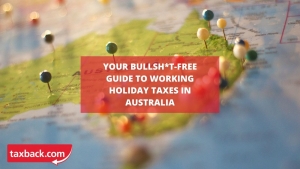Navigating the Oz Tax System for Temporary Visa Holders
With Australia being among one of the most popular destinations for gap years and working holidays, we thought that it might be useful to compile a guide on how the Australian tax system works. In many cases, the Oz tax system is quite different to how tax works in the countries where the working holidaymakers come from, so we’ve put together answers to the questions we get asked most.
Navigating the complexities of the Oz tax system can be challenging, especially for temporary visa holders in Australia. Understanding tax rates, determining your residency status, and knowing the right filing procedures are crucial to ensure compliance and maximize your tax refund. In this guide, we'll break down the essentials of the Oz tax system, providing you with the knowledge and tips needed to confidently manage your tax obligations while living and working in Australia.
What is the tax year in Australia?
The tax year in Australia, part of the Oz tax system, runs from 1 July to 30 June (for example the 2024 tax year runs from 1 July 2023 to 30 June 2024).
Want to Learn More About Australian Tax?
DOWNLOAD YOUR FREE TAX GUIDE HERE
What is the rate of tax in Australia?
Individual tax rates in Oz tax system for temporary visa holders in particular are dependent on the duration of time that you spend in the country and indeed your intentions while you are there.
Correctly determining your tax residency status is very important because it helps you to work out your Australian income tax liability within the Oz tax system.
It’s also crucial to be aware of your tax residency status, so that you can file your tax return properly.
In short, you will be considered a resident for tax purposes in Australia if you have lived and worked in Australia for 183 days of the year. If this is not the case, you will be deemed a non-resident for tax purposes.
When you file your Australian tax return, you will be required to fill out a questionnaire to determine your residency status.
All working holidaymakers in Australia are considered non-residents for tax purposes.
Non-resident tax 2021-2022
All temporary visa holders entering Australia should pay the non-resident rate of tax for their first 6 months in Australia to ensure that they will not encounter any issues when they are departing Australia.
The Oz tax system mandates higher non-resident rates compared to resident rates. If you don’t pay these for at least the first 6 months, you are likely to run into a situation at the end of the year when you will have an underpayment of tax and will need to make a payment to the ATO (Australian Tax Office).
The non-resident rates are as per the table below:
|
Taxable income |
Tax on this income |
|
0 – $120,000 |
32.5c for each $1 |
|
$120,000 – $180,000 |
$39,000 plus 37c for each $1 over $120,000 |
|
$180,001 and over |
$61,200 plus 45c for each $1 over $180,000 |
Resident tax 2021-2022
As the name suggests, this is the rate that residents of Australia pay on their income under the Oz tax system. Temporary visa holders generally are deemed ‘Australian residents for tax purposes’ once they have spent 183 days in Australia, and are then entitled to pay these rates.*
The resident rates of tax are as per the below:
|
Taxable income |
Tax on this income |
|
0 – $18,200 |
Nil |
|
$18,201 – $45,000 |
19c for each $1 over $18,200 |
|
$45,001 – $120,000 |
$5,092 plus 32.5c for each $1 over $45,000 |
|
$120,001 – $180,000 |
$29,467 plus 37c for each $1 over $120,000 |
|
$180,001 and over |
$51,667 plus 45c for each $1 over $180,000 |
*There are numerous other requirements but this is the main qualification requirement – if you are unsure if you qualify for the resident tax rate, it is worth speaking to the ATO or Taxback.
Our average Australian tax refund is AU$2600
Is there a tax free allowance in Australia?
Yes. The Oz tax system provides a tax free allowance in Australia is $18,200, and in order to be entitled to it, you need to be deemed a resident for tax purposes.
What this means in a nutshell is that if you spend more than 183 days in Australia you will be able to earn $18,200 tax free.

When can I apply for my tax back?
To apply for your tax back within the Oz tax system, you need to file a tax return.
Get a FREE estimation with our Australian tax refund calculator. You can file your tax return either at the end of the tax year or when you are permanently departing Australia and don’t intend to work again in the current tax year.
The latter is referred to as an Early Assessment, and this means that temporary visa holders that are heading home or indeed continuing to travel to a new destination and departing Australia before 30 June can file for their refund early.
This process is done via a paper application and takes 6-8 weeks to be processed.
End of year applications are electronic and take 10-12 business days to be processed.
Are there filing deadlines in Australia?
Yes. The Australian tax system requires taxpayers in Australia have from 1 July to 31 October to lodge their income tax return/refund application.
After 31 October, if you have not filed you will need to engage the services of a tax agent as individual tax return filing closes.
This is something that Taxback can assist with.
Want to Learn More About Australian Tax?
DOWNLOAD YOUR FREE TAX GUIDE HERE
What is needed to file a tax return/refund?
The main requirement within the Oz tax system is that you will need to be able to provide details of all your income during the year. This means that you need to keep records of all the jobs you have had and be able to detail the income from each.
At the end of the tax year, each of your employers should issue you with a PAYG (pay as you go) summary and this will detail all this information but we would recommend keeping all payslips also as sometimes when travelling PAYGs get sent to the incorrect addresses etc.
Another source of income that needs to be included on your return/refund application regardless of how small it is – is bank interest.
Most accounts will accumulate bank interest and you need to detail this on the return to avoid any discrepancies that will lead to your file being reviewed and delayed.
In order to find out what needs to be included you should ask your bank for an interest statement which will outline it all.
What can be included in application to minimise tax liability/increase refund?
The only way within the Australian tax system that a taxpayer can minimise tax liability or increase the value of his / her refund is to include work-related expenses.
Work related expenses vary from person to person as they are specific to your core occupation – so, for example if you are bricklayer, you will be able to include expenses for courses relating to that occupation or protective gear, such as steel toe boots etc.
However, you would not be able to claim for something such as a laptop, unless you were able to prove that it was required for you to carry out your job.
Travel is an expense that always comes up when taking about work-related expenses, but it only qualifies in cases where you have been asked by your employer to travel and such travel was not reimbursed.
You cannot include your travel to and from work in your tax return as this is a cost of living as opposed to a work related cost.
Who can claim a tax refund in Australia?
If you have been working in Australia and have paid tax, you can claim a tax refund.
You can only claim a tax refund if you have been in Australia for more than six months.
The average Australian tax refund is $2,600, so it is definitely worth checking what you’re owed!
Will I definitely get a tax refund if I apply?
No, but we’ve found that a lot of non-residents in Australia are eligible to claim a tax refund.
It depends on factors such as how much tax you’ve paid, your income and any offsets and expenses.
The decision on whether or not you’ll get a tax refund ultimately rests with the ATO.
We’ll do everything in our power to reduce your tax liability and maximize your tax refund.
How does Taxback work?
Taxback can file your tax return and will process your refund application for you, the steps involved in this process are:
-
You register online and sign our Authorization forms
-
You sign the forms and send them back to us
-
We’ll estimate your tax refund and provide you with access to your secure online account
-
We’ll track down any missing documents if required
-
We’ll prepare and file your tax return
-
We send you your tax refund
Our average Australian tax refund is AU$2600
Why apply with Taxback?
There are so many reasons that you should apply for your Australian tax refund with Taxback, to name a few:
-
We have 20+ experience in international tax and we filed over 322,000 tax returns last year
-
It's an easy and convenient online service. We’ll manage your application from start to finish
-
We’ll ensure it complies with Australian tax codes
-
We’ll update you on the progress of your application
-
We’ll make sure you get back the maximum legal tax refund
-
Free no-obligation refund estimate and quote
I want to file my tax return and apply for my Australian tax refund with Taxback. How do I get started?
The easiest way to get your tax back is to apply with Taxback. Just fill out our simple form.
If you have any questions, out tax experts are available 24/7 to help you.




